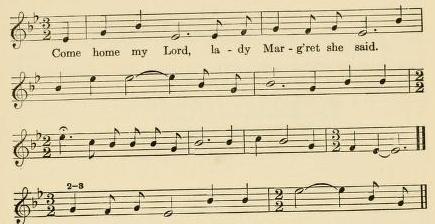Lord Lovel- (NC) c.1940 Brown J, vol. 4
[Single stanza with music from the Brown Collection of NC Folklore; Vol. 4, 1957. A recording is available on-line. The editors' notes follow. It's sad that no one tried to collect the text- it wouldn't have been hard at that time.
R. Matteson 2015]
Lord Lovel (Child 75)
Possibly it is the very simplicity of the sentiment that has made this ballad so persistent a favorite; certainly it has little else (unless, perhaps, the tune) to commend it. For its range since Child's time, both in the old country and in America, see BSM 52. To the texts there listed should be added Kentucky (BTFLS iii 92), Tennessee (SFLQ xi 124-5), North Carolina (FSRA 27-8), Florida (SFLQ viii 150-2), Missouri (OFS i 113-15). Ohio (BSO 39-45), Indiana (BSI 79-91), and Michigan (BSSM 27-8). The texts vary but little, going back, perhaps in all cases, to a London broadside of a hundred years ago, Child's H. To the variations in the name of the church whose bells announce the death of the lady, some of which are listed in BSM, North Carolina adds one more, "St. Banner's" (version B below). For the most part the church is not named in the North Carolina texts; Lord Lovel returns to "Cruel Clark's" (A), to "London Tower" (C), to "London town" (D F G) and hears the bells, but the church is not named. For an adaptation to the purposes of political satire during the Civil War, see volume 111, section ix.
The texts are so much alike that only a few are given in extenso.
J. 'Lord Lovel.' Sung by Mrs. Nora Hicks. Recorded at Mast's Gap, Sugar Grove, Watauga county, in September 1940.

F C Brown says: "More like Earl Brand." Not much of the text can be understood owing to poor recording, but in the last stanza there is a distinct "Lord Lovel."
For melodic relationship cf. **SharpK i 146, No. 21A, basic melodic tendency in first four measures; BT 108; SCB 122; WSSU 177, 3a; ASb 70; FSoA 124; BSO 43, No. 13E, measures 1-2.
Scale: Mode III. Tonal Center: e-flat. Structure: abbk (2,2,2,2) = ab (4,4)-